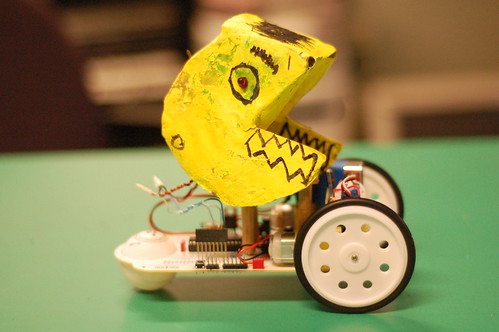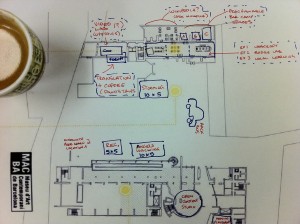ARDUINO AT DRUMBEAT FESTIVAL, BARCELLONAARDUINO AT DRUMBEAT FESTIVAL, BARCELLONAARDUINO AT DRUMBEAT FESTIVAL, BARCELLONA
– November 4th, 2010
As we announced some time ago, we are attending a very challenging event about Education, Freedom and The Web.
We’ve had a super day one developing an obstacle avoiding robot (more info soon) to reach our friends of Hackbus in the middle of MACBA square. We hope we finish the robot by tomorrow. Massimo is having his keynote right now, and you probably can follow his speech here.
We’d like to thank Mozilla to give us such an interesting opportunity to meet so many different people.
more on [DrumBeat] and #drumbeat hashtag on twitter
FIND US AT THE DRUMBEAT FESTIVAL BCN
– November 3rd, 2010
Check this out, it’s the map coming straight from Mozilla’s Drumbeat Festival in BCN happening this week. Meet us there!
Get a lot more info here. Follow them on their media dashboard here.
FLASH / ARDUINO BASED SPEED DETECTORFLASH / ARDUINO BASED SPEED DETECTORFLASH / ARDUINO BASED SPEED DETECTOR
– November 2nd, 2010
[Mike Chambers] developed a nice Flash / Arduino based speed detector with clients for Mac, Windows and Android based devices (via Adobe AIR 2.5 beta).
Here is how it works. I have an Arduino Duemilanove with ATMega328 which has two photo-resistors connected (with a 10k pull down resistor). I set up two laser pointers to shine a laser directly onto the photo-resistor (which is enclosed within a dark box). The Arduino monitors the values returned from the light sensor, and watches for any changes that indicate that the laser bean has been broken. When both laser beams are broken, the Arduino calculates the amount of time between when each sensor was tripped. It then sends that value to the Adobe AIR based client, which is connected to the Arduino via USB / Serial port and a serial port proxy (in the case, TinkerProxy).
You can get the schematics and the codes from this project on Mike’s github.
via [MikeChambers]
ARDUINO PAYPAL VENDING MACHINEARDUINO PAYPAL VENDING MACHINEARDUINO PAYPAL VENDING MACHINE
– October 29th, 2010
[...]This PayPal vending machine on exhibit at the PayPal X Innovate 2010 developers conference was created by Ray Tanaka and his crew at PayPal Labs.They hacked together the multi-part system using a mechanical candy dispenser, a couple of Arduino Duemilanove, a WiShield, relay, proximity sensor, and LED display.The end result allows you to scan a QR code, make a payment, and acquire munchies using a smartphone. As you make your payment, the machine will tweet your purchase and notify a confirmation display.
via [helablog]
HACK IN THE BOX 2010 MALAYSIAHACK IN THE BOX 2010 MALAYSIAHACK IN THE BOX 2010 MALAYSIA
– October 27th, 2010

[Amy] wrote us about Hack In The Box conference Malaysia 2010 and the Hard Hack Village workshops about Arduino and related.
The attendees (and many speakers!) definitely enjoyed the hands-on tinkering, both at the lab and the village. We also saw a substantial number of attendees committing two hours for the Arduino lab. Echoing Amsterdam, Arduino was a great feature for HITB Malaysia this year – it was very popularly received by a highly enthusiastic HITB dotMy audience.For now, the HITB team’s catching up on sleep. Our next conf will be in Amsterdam in May 2011 – hopefully we’ll see some of you there!
We hope so Amy. You did great though!
more cool pictures [here] via [HackInTheBoxConference]
ARDUINO A SCUOLA #2 – LIVE FROM MAJORANAARDUINO A SCUOLA #2 – LIVE FROM MAJORANA
– October 26th, 2010

Come preannunciato qualche tempo fa, oggi viene presentata una sperimentazione ai docenti di scuola superiore per la riforma del secondo ciclo basato sulla tecnologia Arduino. Se ci vedete nel video poco sotto vuol dire che Topix e DocAbout hanno fatto il loro dovere (grazie).
This text will be replaced
Se avete problemi andate alla diretta su Dchola.tv.
Per maggiori informazioni: la pagina di riferimento del Majorana, e il nostroprecedente post.
UPDATE: se volete rivedere l’evento potete farlo dal sito di Docabout.

Come preannunciato qualche tempo fa, oggi viene presentata una sperimentazione ai docenti di scuola superiore per la riforma del secondo ciclo basato sulla tecnologia Arduino. Se ci vedete nel video poco sotto vuol dire che Topix e DocAbout hanno fatto il loro dovere (grazie).
This text will be replaced
Se avete problemi andate alla diretta su Dchola.tv.
Per maggiori informazioni: la pagina di riferimento del Majorana, e il nostroprecedente post.
LECTURE ON OPEN HARDWARE AT CCEMXCHARLA SOBRE HARDWARE ABIERTO EN EL CCEMX
– October 26th, 2010
David Cuartielles is presenting the work made with open source tools at Faro de Oriente, Mexico City, during the last two years. The talk will include some reflections about how to introduce hardware in locations where it is not easy to import components, the creation of knowledge blocks in the right size for kids, using Arduino starter kits as a way to introduce programming at early ages, and the insane love for Sumo Robots that kids have.

pacman robot by kids at Faro de Oriente, (c) 2010 D. Cuartielles
The lecture will take place at CCEMX, Centro Cultural de España en México, on Friday October 29th at 7PM local time, 8PM EST, 2AM CET (one day later). Many of the ideas collected during this project will for sure influence our future projects dealing with secondary education.
David Cuartielles presentará el trabajo realizado con herramientas abiertas en el Faro de Oriente, México DF, durante los últimos dos años. La charla incluirá aspectos relacionados con temas como la introducción de hardware en localizaciones dónde no es fácil importar componentes, la creación de bloques de conocimiento con el tamaño apropiado para chicos/as, el uso de kits de iniciación a Arduino para enseñar programación en edades tempranas, y el increible amor de los chicos/as por robots luchadores de sumo.

pacman robot por chicos del Faro de Oriente, (c) 2010 D. Cuartielles
La presentación tendrá lugar en el CCEMX, Centro Cultural de España en México, el viernes 29 de Octubre a las 7PM hora local, 8PM EST, 2AM CET (un día más tarde). Muchas de las ideas recogidas durante el desarrollo de este proyecto influirán seguramente en futuros proyectos teniendo que ver con Arduino en educación secundaria.
MULTI-TOUCH INPUT SENSOR BASED OF ARDUINO MEGAMULTI-TOUCH INPUT SENSOR BASED OF ARDUINO MEGAMULTI-TOUCH INPUT SENSOR BASED OF ARDUINO MEGA
– October 25th, 2010
Possible low-end solution for multi-touch surfaces based on Arduino Mega:
So i’ve been working on this project for a while now as part of my thesis and independently and work is still continuing. So just an overview the project is a multi-touch and multi-modal input sensor that can be utilised behind traditional LCD panels utilising a new method to detect inputs. By using a large IR sensor array consisting of 128 sensors behind the LCD panel and IR light source in front of the Panel we are able to augment the display with the ability to sense a variety of objects near or on the surface; including fingers tips and hands and thus permitting us to enable multi-touch interaction. The inherent nature of the senors allows us to create a low cost high fidelity image sensor allowing us to take advantage of optical sensing which also allows other physical items to be detected, and thus permits us to develop multi-modal interaction schemas.
Amazingly done with Processing and a simple Arduino Mega board.
via [ArduinoForum] source [mtaha]
ARDUINO UNO AS JOYSTICKARDUINO UNO AS JOYSTICKARDUINO UNO AS JOYSTICK
– October 24th, 2010
Arduino Forum User [ant.b] has shared his personal Arduino UNO hack with other LUFA firmwares. He tries to turn an Arduino UNO in a Joystick, uploading a new firmware on the 8u2, and summarize it in a very useful step by step guide.
LECTURE: EDUCATIONAL ROBOTS WITH ARDUINO
– October 21st, 2010
Eduardo Gallego, the trainer to the Complubot robotics team from Spain is going to make an online lecture about the way he uses Arduino techology to teach kids about building robots. He announced it on this forum post. If you are good in Spanish, hook up with the video stream live tonight!
The lecture will be at 7PM CET, October 21st, 2010, and you can either follow it at:












0 comentarios:
Publicar un comentario